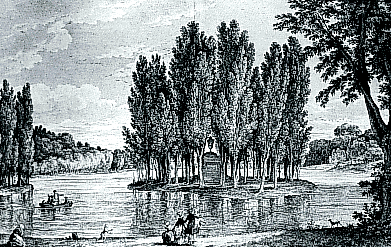The Marquis Rene-Louis de Girardin (1735–1808) was a French writer and designer of landscapes, who had inherited a significant fortune from his grandfather, the chief tax collector for Louis XIV. He saw several English landscape gardens during his travels in the early 1760s, and in 1766 settled at Ermonville in Oise, France, where he laid out his influential landscape garden. He was strongly aware of the importance of associations in gardens, used to trigger memories, stimulate ideas, and create a narrative.
Girardins textbook on gardening, De la composition des paysages (On the Composition of Landscapes) was published in 1777 and republished in 1805, under the name René Louis Gerardin. "Of the power of landscapes over our senses, and as a result upon our soul" was his pre-eminent view on the purpose of gardens.
"The composition of landscapes," he wrote, "can open the way to the renewal of the moral principles of the nation." He wrote in the last chapter, "...If you want to achieve true happiness, you must always seek the simplest means and the arrangements closest to those of nature, because only those are true and will have a long-lasting effect."
Girardins garden at Ermonville stands as the most prominent example of a Rousseau-inspired garden. In his novel "La Nouvelle Helois" Rousseau imagined a perfect landscape, where people could be true to themselves. This imaginary garden became a model for French landscape gardens. Girardin made the park at Ermenonville a living illustration of Rousseaus ideas; making carefully constructed landscapes, like paintings, designed to invite the visitor to take long walks and to feel pure with simple emotions. The paths were designed to follow the hillside paths, climbing up and down, to give various views and perspectives, from the shadows of groves of trees which then extend into sunlight, meandering to let the viewer delight in the scene from different angles and light. Girardin said that gardens should be composed of a series of scenes, like paintings. Each designed to be seen from a different point of view and at different times of day to achieve an emotional effect. Some scenes should evoke solitude, others the pleasures of bucolic life, others the ideals of harmony and innocence. These scenes would be discovered by following a winding path through the garden, with a series of different views coming as surprises.

It is commonly known that his friend, Jean-Jacque Rousseau died on his estate in 1778, and was buried on the Île des Peupliers in the Élysée that Girardin had created. Surrounding Rousseaus cenotaph is a circle of poplar trees set upon a tiny island. According to landscape historian Elizabeth Rogers, "Imitations of Rousseau’ s gravesite became one of the great garden design flourishes of the late eighteenth century."

Isle of the Poplars/an homage to philosopher Jean Jacques Rousseau
As an aside to these Rousseau-inspired landscapes, Christophe Girot* recounts an essay by French historian Michel Conan on the "static foundations of landscape scenography". He argues that the "art of the picturesque forwarded a static understanding of landscape where movement was absent, or not acknowledged. The picturesque landscape was experienced rather as a succession of immobile scenes as in the example of the romantic promenade of Ermonville.... the voyage through the landscape could only be understood as a succession of immobile scenes lending themselves to the memory and aesthetic interpretation." Girot then asks us to review these spaces in-between the scenes of landscape beauty... "the black holes" and reconsider their value to us.
*"Vision in Motion: Representing Landscape in Time", The Landscape Urbanism Reader, 2006
**Map of Ermonville: Ermenonville : le parc Jean-Jacques Rousseau
0 comments:
Post a Comment